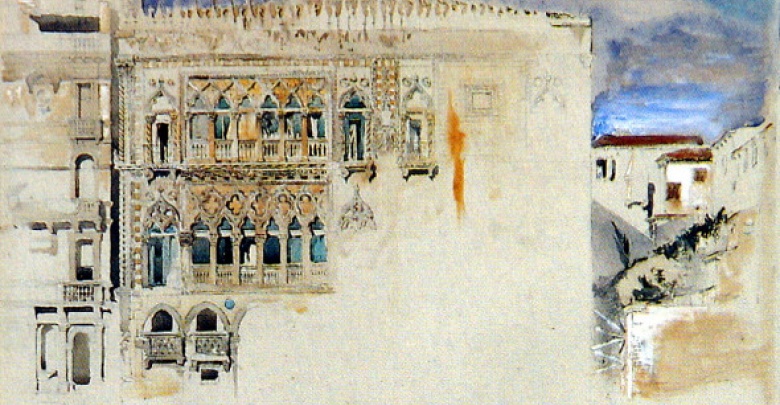What would be the myth of Venice without Ruskin? John Ruskin (1819-1900), an English writer, painter and art critic, was a major figure in the nineteenth-century international art scene with a deep attachment to Venice, to which he dedicated his most famous literary work The Stones of Venice, a study of the city’s architecture and a hymn to its beauty, uniqueness and fragility.
Ruskin, who strongly influenced the aesthetics of his day through his interpretation of art and architecture, now returns to Venice, to the very places that inspired him: to the Doge’s Palace, an emblematic building that he explored extensively from different perspectives in his notebooks, watercolours, architectural reliefs, plaster casts, albums and platinum prints. Ruskin returns to the sequence of rooms and loggias he often portrayed, where Pier Luigi Pizzi’s scenography emphasises the architecture and sculpture of Gothic, Byzantine, Medieval and Anti-Classical Venice that Ruskin loved.
Conceived by Gabriella Belli as a tribute to the knowledge and myth of Venice, and curated by Anna Ottani Cavina, the exhibition is the firstmajor presentation in Italy of an artist who “crossed every border in the name of an interdisciplinary vision, which he practised even before the term itself was coined”. Unable to cover all the areas of Ruskin’s complexity and his versatile genius, the exhibition presents almost a hundred paintings that document his vocation for translating reality into images, capturing in thousands of watercolours and drawings in pen “his tireless attempt to understand the world”. Ottani Cavina writes that “Ruskin’s colourful vision will be a revelation to the Italian public, since Ruskin is the greatest Victorian watercolourist”.
The exhibitions both an exhortation for the salvation of Venice and a challenge to celebrate John Ruskin as a great and unique painter, apart from his eclecticism and his own determination to favour the written word. The city, the architecture, the Venetian masters, the tension between curiosity and imagination when exploring nature are the leitmotivs of this encounter with paintings by an artist who was a forceful critic battling for modernity, one who recognised in particular the revolutionary force of Turner’s painting, whose work has also been included in the exhibition in the form of several extraordinary portrayals of the lagoon city: Venice: The Dogana and Santa Maria della Salute, Venice from the Washington National Gallery of Art and Venice, the Ceremony of the Doge Marrying the Sea from Tate Britain, London.
In addition to Ruskin’s travels in Italy and his fascination with nature, captured in a series of watercolours that focus on the theme of the Italian mountains and landscapes, the actual core of the exhibition is the relationship between Ruskin and Venice. This bond, cultivated over the course of a lifetime, from his first visit at sixteen and through eleven further visits between 1835 and 1888, is explored from different points of view: Studies of Clouds, Sunsets, Full Moons, Views of the Lagoon, Studies by the Great Venetian Painters: Carpaccio, Veronese, Tintoretto, but focuses essentially on the crucial theme of the “nature of Gothic” and its rediscovery and celebration. The reference text is Ruskin’s magnificent book The Stones of Venice (1851-1853, 3 volumes), accompanied by the folio illustrations Examples of the Architecture of Venice, published in the same years, and St. Mark’s Rest, which began as a revision of The Stones of Venice but became a guide to the city “for the few travellers who still care about its monuments”.
The works on show come from major museums all over the world, since Italian public collections hold no work by Ruskin. Finally, to complement this fascinating journey, there is also a selection of the Venetian Notebooks (sketchbooks, measurements, plans, cross sections and dense notes), Ruskin’s original manuscripts for The Stones of Venice in the form of blue paper fragments never before exhibited and conserved at the Morgan Library & Museum, New York, several printed first editions, daguerreotypes, historical photos of Venice, and well-known paintings alongside the studies Ruskin drew of them while in Venice.
| Mo | Di | Mi | Do | Fr | Sa | So |
|---|---|---|---|---|---|---|
|
1 |
2 |
3 |
4 |
5 |
6 |
7 |
|
8 |
9 |
10 |
11 |
12 |
13 |
14 |
|
15 |
16 |
17 |
18 |
19 |
20 |
21 |
|
22 |
23 |
24 |
25 |
26 |
27 |
28 |
|
29 |
30 |
|
|
|
|
|
From April 1st to October 31st 8.30 am – 7 pm (last admission 6 pm) from November 1st to March 31st 8.30 am – 5.30 pm (last admission 4.30 pm)
